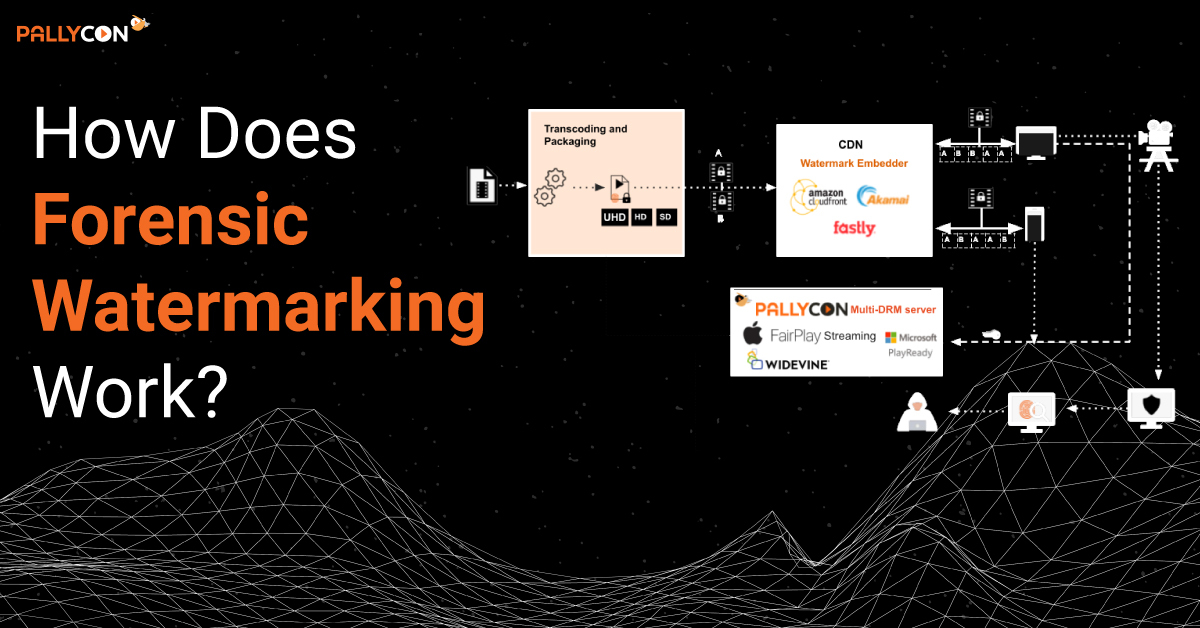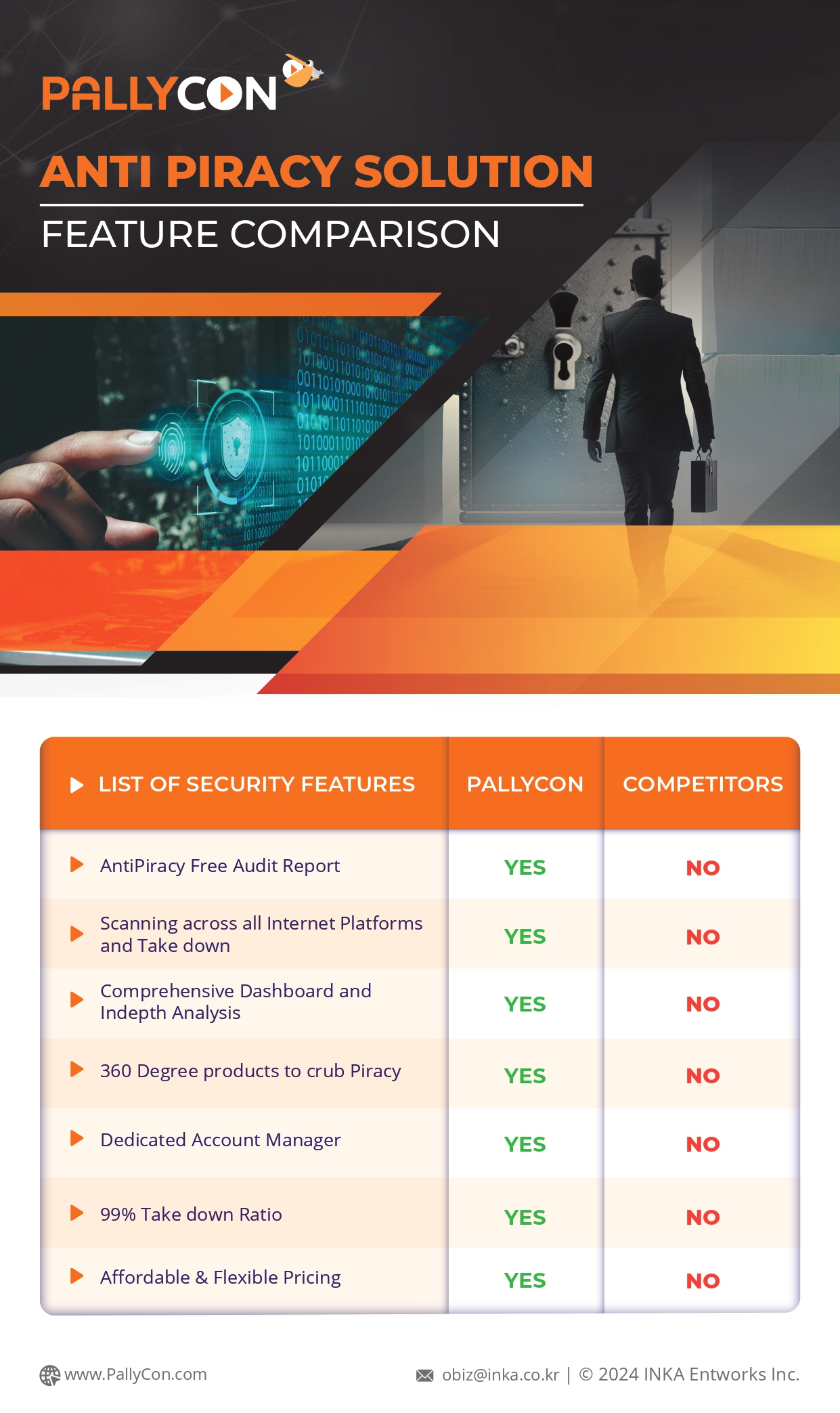
Functions of Forensic Watermarking
Forensic watermarking is a way to embed unique, hidden data into digital content, such as videos. It is embedded in a way that does not change the quality or the viewing experience of the video. This invisible marker works as a digital fingerprint that links the content to a specific recipient or distributor.
The watermark is created using sophisticated algorithms that encode data into less perceptible parts of the video, such as its frequency domain or metadata. The embedding process can be done during content encoding (server-side) or on the viewer’s device (client-side).
Once embedded, the watermark becomes an integral part of the file and remains intact even if the content is compressed, cropped, or slightly altered. The forensic watermarking workings start when a suspicious or pirated version of the content is found, specialized tools extract the watermark to trace its origin and identify who is responsible for the leak.
Thereby one of the primary functions of Forensic watermarking is robust protection for intellectual property, helping content creators and distributors maintain control over their assets in a secure and effective way.
How Forensic Watermarking Protects Video in a Multi-Screen World?
Today, the multi-screen world is not limited to televisions and theatres but it also includes smartphones, TVs, tablets, and laptops, as people view content from all these devices and from anywhere. Therefore, protecting content across all platforms is a major challenge now. as the same person can view the same content from multiple devices and different places. Forensic watermarking offers a seamless solution by embedding hidden identifiers into video files that persist regardless of how the content is played or shared.
The functions of Forensic watermarking ensure that every copy of a video distributed to a user is uniquely watermarked. If an illegal copy is found circulating in an unauthorised manner across platforms, then using watermarked information, the source of the leak can be traced. This is especially useful in streaming platforms, where users access content on various devices.
Also, the best part about forensic watermarking is that it works behind the scenes without disrupting the viewing experience. It can survive common alterations like resizing, compression, or format changes, making it highly effective in detecting unauthorized usage.
By enabling content/studio production houses, Edutech, OTT, and live streaming to track and trace pirated material, forensic watermarking acts as a powerful deterrent against piracy. It is especially crucial for live events, sports broadcasts, and premium video-on-demand services, ensuring that the content remains secure across multiple screens.
Does Forensic Watermarking Affect Video Quality?
No, forensic watermarking functions in a way that does not affect video quality. The technology is designed in such a way that it embeds hidden, imperceptible markers within the video without altering its appearance or playback quality.
Forensic watermarking workings include areas of the video that are hardly noticeable to the human eye, such as in the frequency domain or metadata. This ensures that the viewer enjoys a seamless experience while the content remains protected.
Advanced algorithms also ensure that watermarks remain robust against compression, resizing, and other common alterations without impacting quality. However, if poorly implemented, slight visual defects may occur, but this is rare with modern tools.
Forensic watermarking strikes the perfect balance between content security and user experience, making it a trusted solution for protecting videos in the digital age.
What Happens in the Event of a Leak?
When a leak occurs, anti-piracy measures like forensic watermarking is the key to identifying the source and taking action. Here’s what happens step-by-step:
Detection phase :
Once a pirated version of the content is discovered online or shared illegally, investigators analyze the file using specialized watermark detection tools.
Watermark Extraction :
The hidden watermark embedded in the content is extracted. This watermark contains unique identifiers, such as user information, timestamps, or distributor details.
Source Identification :
By decoding the watermark, investigators trace the leak back to its source. This could be an individual user, a streaming account, or a distributor.
Action :
Based on the findings, the content owner can take appropriate action. This might include shutting down unauthorized streams, issuing legal notices, or revoking access for the person responsible.
Forensic watermarking not only helps trace leaks but also acts as a strong deterrent. When users know that content is watermarked, they are less likely to share it without permission. This ensures that content creators can protect their intellectual property effectively and hold offenders accountable.
Why is Forensic Watermarking Important for Digital Content Protection?
Forensic watermarking along with video DRM is essential for protecting digital content in a world where piracy and unauthorized sharing are rampant
Reports revealed that in 2023 alone, video piracy sites have been visited 141 billion times, which is a 12% increase from 2019.
With the ability to embed invisible markers into videos, creators can track their content and hold violators accountable.
Piracy has caused significant losses to different economies worldwide. According to a study from Park Associates, piracy for streaming services is estimated to increase from 22% in 2022 to 24.2% in 2027. The losses would be faced by content creators, especially in industries like film, music, and online education. Here is where forensic watermarking functions as it addresses this by identifying the exact source of leaks. Unlike visible watermarks, forensic watermarks do not affect content quality, ensuring a seamless experience for viewers while securing the content.
This technology isn’t limited to tracking distribution but it also traces accountability. Each piece of distributed content carries a unique identifier, which ties it to the recipient. If unauthorized sharing occurs, the watermark reveals who is responsible, enabling swift action.
Forensic watermarking is particularly important for live events like sports or music, exclusive video-on-demand services, and sensitive educational content. It ensures that creators can distribute their work confidently, knowing it is protected against misuse.
FAQs on Forensic Watermarking Workings
How is Forensic Watermarking different from visible watermarking?
Visible watermarks are logos or text overlays seen on the screen, while forensic watermarks are hidden and do not affect content quality.
Is forensic watermarking secure?
Yes, it uses advanced algorithms to ensure watermarks remain intact even after compression, resizing, or editing.
Does it slow down video playback?
No, forensic watermarking operates in the background without disrupting playback or user experience.
Can forensic watermarking be used for live content?
Yes, it is widely used for live events and sports broadcasts to track and deter unauthorized streams.

Harish Bhat is a Forensic watermark Product Manager at PallyCon and has been associated with media and broadcasting industry for over 13 years. Apart from technical writing, an avid reader of latest trends in the streaming world and content protection.
